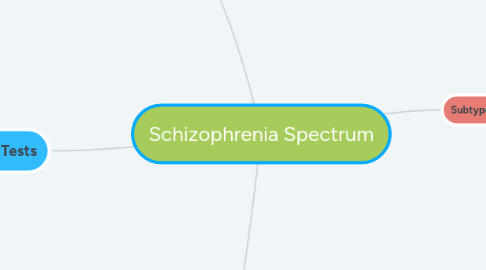
1. Objective Tests
1.1. Diagnostic and Rating Scales for Schizophrenia
1.1.1. Positive and Negative Syndrome Scale (PANSS)
1.1.2. Brief Psychiatric Rating Scale (BRPS)
1.1.3. Simpson Angus Scale (SAS)
1.1.4. Abnormal Involuntary Movement Scale (AIMS)
1.1.5. Barnes Akathisia Rating Scale (BARS)
1.2. Psychological Testing
1.2.1. Intelligence Tests
1.2.1.1. Patients score lower
1.2.2. Projective and Personality Tests
1.2.2.1. May indicate bizarre ideation
2. Treatment
2.1. Pharmacotherapy
2.1.1. 1st Gen Antipsychotics
2.1.1.1. Dopamine D2 Antagonists
2.1.1.1.1. S/E: Extrapyramidal symptoms; Tardive dyskinesia
2.1.2. 2nd Gen Antipsychotics
2.1.2.1. Antagonize serotonin and dopamine receptors
2.1.2.1.1. Higher risk of metabolic syndrome; Lower incidence of extrapyramidal side effects
2.2. Psychosocial Therapy
2.2.1. Cognitive Behavioral Therapy
2.2.1.1. Improves cognitive distortions, reduces distractibility, corrects errors in judgement
2.2.2. Social Skills Training
2.2.2.1. Behavioral skills therapy
2.2.2.1.1. Reduces relapse rates and need for hospitalization
2.2.3. Group Therapy
2.2.3.1. Helps improve social functioning, decreases negative symptoms
2.2.4. Family-oriented Therapies
2.2.4.1. Psychoeducation and problem-solving training
2.2.5. Case Management and Assertive Community Treatment
2.2.5.1. Variety of professionals are involved in a treatment program
2.2.6. Invidual Psychotherapy
2.2.7. Vocational Therapy and Supported Employment
2.2.7.1. Helps patients regain old skills or develop new ones
2.2.8. Art Therapy
2.2.8.1. Outlet; helps patients communicate with others
2.2.9. Cognitive Remediation
2.2.9.1. Computer-generated exercises to influence neural networks to improve cognition
2.2.10. National Alliance on Mental Illness (NAMI)
2.2.10.1. Offer support groups for family members and friends who are mentally ill
3. Pathophysiology
3.1. Dopamine Hypothesis
3.1.1. Increased dopamine activity
3.2. Genetics
3.2.1. Monozygotic twins
3.2.1.1. Higher concordance rate compared to dizygotic twins
3.3. Psychoanalytic Theories
3.3.1. Development fixations in early life
3.3.1.1. Defects in ego development
3.3.2. Distortions in the mother-infant relationship
3.3.3. Adaptive method to avoid panic, terror and disintegration of the sense of self
3.4. Learning Theories
3.4.1. Children learn irrational reactions and ways of thinking
3.4.1.1. Imitate parents who have emotional problems
4. Subtypes
4.1. Schizophrenia
4.1.1. Key Features
4.1.1.1. Positive Symptoms
4.1.1.1.1. Hallucinations Delusions Bizarre behavior Disorders of thought Disorganized speech
4.1.1.2. Negative Symptoms
4.1.1.2.1. Flat affect Alogia Avolition Anhedonia Social withdrawal
4.1.1.3. Cognitive Symptoms
4.1.1.3.1. Inattention Diminished working memory Impairment in executive functioning
4.1.2. Epidemiology
4.1.2.1. Risk Factors
4.1.2.1.1. Born in winter or early spring
4.1.2.1.2. Prenatal exposure to influenza virus
4.1.2.1.3. Maternal complications during delivery
4.1.2.1.4. Childhood trauma, social isolation
4.1.2.1.5. Urban living
4.1.2.1.6. Immigration
4.1.2.1.7. Cannabis use
4.1.2.1.8. Cognitive deficits
4.1.2.2. Prevalence
4.1.2.2.1. Men
4.1.2.2.2. Women
4.1.2.3. Age
4.1.2.3.1. Men
4.1.2.3.2. Women
4.1.3. Diagnosis
4.1.3.1. At least 2, with at least 1 from the 1st 3
4.1.3.1.1. Delusions Hallucinations Disorganized speech Disorganized catatonic behavior Negative symptoms
4.1.3.2. Onset at least 6 months prior to diagnosis
4.1.3.2.1. Requires at least one month of active symptoms over the past 6 months
4.1.3.3. Not better explained by
4.1.3.3.1. Substances
4.1.3.3.2. Other medical conditions
4.1.3.3.3. Other psychiatric conditions
4.1.3.4. With Catatonia
4.1.3.4.1. 3 or more
4.2. Schizoaffective Disorder
4.2.1. Key Features
4.2.1.1. Schizophrenia
4.2.1.2. Mood Disorder
4.2.1.2.1. Major Depressive Disorder Bipolar Disorder
4.2.2. Diagnosis
4.2.2.1. >2 weeks of psychotic symptoms alone
4.2.2.1.1. No manic or depressive episodes during periods of psychosis
4.2.3. Not better explained by
4.2.3.1. Substance use
4.2.3.2. Another mental illness
4.2.3.3. Another medical condition
4.3. Schizophreniform Disorder
4.3.1. At least 2 psychotic symptoms lasting 1-6 months
4.4. Brief Psychotic Disorder
4.4.1. Key Features
4.4.1.1. At least 1 positive symptom lasting <1 month
4.4.1.1.1. Hallucinations
4.4.1.1.2. Delusions
4.4.1.1.3. Disorganized thought
4.4.1.2. Behavioral symptoms
4.4.1.2.1. Emotional volatility
4.4.1.2.2. Strange or bizarre behavior
4.4.1.2.3. Screaming/Muteness
4.4.1.2.4. Impaired memory of recent events
4.4.2. Risk factors
4.4.2.1. Female Low socioeconomic status Immigrant Major psychosocial stressors
4.5. Delusional Disorder
4.5.1. Symptom Specifiers
4.5.1.1. Erotomaniac type
4.5.1.1.1. Believes a person of higher status is in love with them
4.5.1.2. Grandiose type
4.5.1.2.1. Delusion of grandeur
4.5.1.3. Jealous type
4.5.1.3.1. Believes that a partner is unfaithful
4.5.1.4. Persecutory type
4.5.1.4.1. Believes others are trying to harm them
4.5.1.5. Somatic type
4.5.1.5.1. Believes that they have a physical disorder
4.5.1.6. Mixed type
4.5.1.6.1. More than one of the above
4.5.1.7. Unspecified type
4.5.2. Diagnosis
4.5.2.1. Duration >1 month with at least 1 type
4.5.2.1.1. No mood disorder, no psychotic symptoms
4.5.3. Folie à deux (Shared psychosis)
